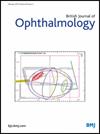Adverse renal events between ranibizumab and aflibercept in patients with diabetic macular oedema in Taiwan: a comparative cohort study
IF 3.7
2区 医学
Q1 OPHTHALMOLOGY
引用次数: 0
Abstract
Aims To assess and compare the risk of adverse renal events among patients with diabetic macular oedema (DME) who were treated with either intravitreal ranibizumab or aflibercept in Taiwan. Methods We conducted a population-based retrospective cohort study and employed a target trial emulation framework using Taiwan’s National Health Insurance Database from 2011 to 2018. Patients aged over 20 years diagnosed with DME and receiving treatment with either intravitreal aflibercept or ranibizumab were included. We applied propensity score methods to ensure balance in the baseline characteristics between the two treatment groups. The primary outcomes were the adverse renal events, specifically acute renal injury and hospitalisation due to renal events. We employed Cox proportional hazards models to estimate the HRs associated with these outcomes. Results A total of 6330 patients receiving ranibizumab and 1258 patients receiving aflibercept were included in this study. The incidence rates of adverse renal events were 102.2 and 138.7 per 1000 person-years for ranibizumab and aflibercept, respectively. Patients treated with intravitreal aflibercept had a significantly higher risk of experiencing a composite of adverse renal events (HR: 1.42; 95% CI: 1.24 to 1.63), compared with those treated with ranibizumab, and specifically also a higher risk of acute kidney injury (HR: 1.32; 95% CI: 1.08 to 1.63) and hospitalisation due to renal events (HR: 1.43; 95% CI: 1.25 to 1.64). Conclusion In comparison to ranibizumab, the intravitreal use of aflibercept was associated with a greater risk of adverse renal events. These findings provide a solid foundation for future studies to validate these results further. Data may be obtained from a third party and are not publicly available. The analytic datasets of this study are available in the NHIRD (台湾糖尿病性黄斑水肿患者的肾脏不良事件:一项比较队列研究
目的评估和比较台湾地区糖尿病性黄斑水肿(DME)患者接受玻璃体内注射雷尼单抗或阿非利塞普治疗时肾脏不良事件的风险。方法采用2011 - 2018年台湾全民健康保险数据库,开展基于人群的回顾性队列研究,并采用目标试验模拟框架。患者年龄超过20岁,诊断为二甲醚并接受玻璃体内注射阿非利塞普或雷尼单抗治疗。我们应用倾向评分方法来确保两个治疗组之间基线特征的平衡。主要结局是肾脏不良事件,特别是急性肾损伤和因肾脏事件住院。我们采用Cox比例风险模型来估计与这些结果相关的hr。结果本研究共纳入6330例接受雷尼单抗治疗的患者和1258例接受阿非利西普治疗的患者。雷尼单抗和阿非利西普的肾脏不良事件发生率分别为102.2和138.7 / 1000人年。玻璃体内注射阿布西普治疗的患者出现一系列肾脏不良事件的风险显著增加(HR: 1.42;95% CI: 1.24至1.63),特别是急性肾损伤的风险更高(HR: 1.32;95% CI: 1.08 - 1.63)和因肾脏事件住院(HR: 1.43;95% CI: 1.25 ~ 1.64)。结论:与雷尼单抗相比,玻璃体内使用阿非利西普与肾脏不良事件的风险更高相关。这些发现为进一步验证这些结果的未来研究提供了坚实的基础。数据可能会从第三方获得,并且不会公开提供。申请人必须遵守电脑处理个人资料保护法及相关规定。所有申请都经过审查以批准数据发布。
本文章由计算机程序翻译,如有差异,请以英文原文为准。
求助全文
约1分钟内获得全文
求助全文
来源期刊
CiteScore
10.30
自引率
2.40%
发文量
213
审稿时长
3-6 weeks
期刊介绍:
The British Journal of Ophthalmology (BJO) is an international peer-reviewed journal for ophthalmologists and visual science specialists. BJO publishes clinical investigations, clinical observations, and clinically relevant laboratory investigations related to ophthalmology. It also provides major reviews and also publishes manuscripts covering regional issues in a global context.

 求助内容:
求助内容: 应助结果提醒方式:
应助结果提醒方式:


